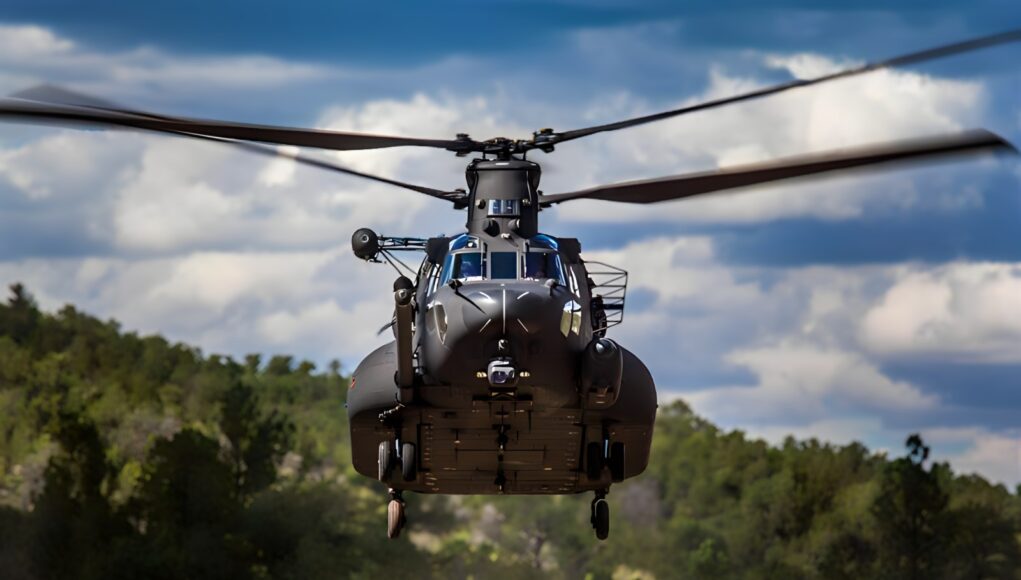Collins Aerospace, a division of RTX, has secured a $19 million contract from the U.S. Department of Defense to equip a fleet of new H-47 Chinooks for the Royal Air Force with its Common Avionics Architecture System (CAAS).
This upgrade aims to make UK Chinooks compatible with U.S. Chinooks by standardising the avionics systems, incorporating advanced digital cockpit displays, and improving various operational applications, according to a press release.
Dave Schreck, vice president and general manager of Military Avionics and Helicopters at Collins Aerospace, highlighted the importance of interoperability, stating, “Interoperability with our allies will be crucial in the future fight, particularly when it comes to maintaining air dominance.”
He further noted that adopting the same modernised flight deck technology across both UK and U.S. aircraft could help the forces collaborate more effectively, reduce workload, and potentially improve operational effectiveness and safety in challenging environments.
The CAAS system, designed with a ‘Flight2 Modular Open Systems Approach’ (MOSA), integrates multiple communications, navigation, and mission sensor subsystems. The modular approach allows for flexibility in both hardware and software, which could facilitate more cost-effective upgrades and system enhancements over time.
According to Collins Aerospace, this open architecture may also reduce long-term sustainment costs throughout the aircraft’s operational life. Collins will also be responsible for conducting necessary data analysis and testing to meet the Ministry of Defence’s airworthiness standards.
This development aligns with the UK’s broader efforts to enhance its heavy-lift capabilities. Earlier in 2024, the UK government confirmed the purchase of 14 extended-range Chinooks, a move expected to contribute approximately £151 million to the UK economy. Collins Aerospace will carry out work related to this contract in Cedar Rapids, Iowa, and Huntsville, Alabama, as part of its ongoing collaboration with the Ministry of Defence to meet evolving military requirements.














Desperate need for AAR for Chinook. Cr@p Voyager can’t refuel then. But other NATO states can do.
👍
is it more desperate to be able to refuel Chinooks or Poseidon and Wedgetail? If you are right about the Chinook then the Voyager can do none of the above.
The Voyager cannot fly slow enough to safely refuel the Chinook in flight. A Chinook cruises at 150 knots. The A330 is quoted as having a stall speed of 120 knots. Which seems doable for the Chinook. But at these speeds the flight controls of the Voyager will be slow and fairly slow to respond. Especially when you probably have to do the mid-air refuel below 10,000ft, as the Chinook is unpressurized. Which means the very large Voyager will be at the whim of gusts, thermals and air pockets.
A more sensible aircraft to do the mid-air refueling is the Hercules. It and the Chinook are a known quantity when it comes to refueling, as they’ve been doing it since the 1980’s. The A400M has just been cleared, but it generates significant wake behind the props. Hence why they had to use double length hoses. To make sure the helicopter was not in the full force of the wake.
Mid-air refueling is a hard maneuver for the pilot to master. Doubly so for a helicopter pilot. As the downwash off the blades pushes the drogue basket down. But it will then bob up as the blade and wash passes. So in essence it oscillates. The pilot has to predict the movement to then spear the rogue with the probe and make the connection.
The E7 and P8 should have a higher priority to be refueled from the Voyager. Again the A330 MRTT that the Voyager is based on is also configured for the flying boom refueling configuration, as used by a number of MRTT customers. Do our Voyagers have the lower fuselage strengthening or will it require going back to Airbus for modifications? There will be a cost, but I feel it’s one the MoD should do. As it will multiple the operational effectiveness and availability of our E7 and P8 aircraft.
As the A330MRTT can’t refuel helicopters we could use A400M without penalty.
Was just about to point out exactly this. There may be some problems with the Voyager contract, but this is not one of them: it does not restrict other refuelling activities that it is not capable of delivering itself.
You couldn’t design Voyager to tank rotory.
However Atlas has been proven as a stable platform.
A400M could now if we bought the pods